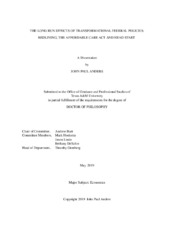| dc.description.abstract | My dissertation research spans several subfields of applied microeconomics, including public,
health and urban economics. In particular, my dissertation is concerned with identifying the longrun
effects of large, transformational Federal policies. My research shows how increases in access
to credit markets, early childhood education and medical care can influence the course of a person’s
life.
In the first chapter, my Job Market Paper, I show how racially motivated restrictions to credit
markets implemented in the 1930s, which are colloquially called “redlining”, influence the present
day distribution of crime. I employ two regression discontinuity (RD) designs. First, I use a spatial
RD to show that redlining influenced the present day distribution of crime across neighborhoods
in Los Angeles, California. Secondly, I use a city-level RD design that relies on an unannounced
population cutoff used to determinate which cities were redline-mapped. I find both that redlining
increased crime in predominantly Black and Hispanic neighborhoods in Los Angeles and that
redline-mapping a city increased Black and Hispanic crime victimization in that city. I also find
that redline-mapping increased city-level racial segregation, which suggests a mechanism through
which credit-access restrictions could have influenced long-run crime volume.
In the second chapter, which is a separate sole-authored paper, I exploit the staggered statelevel
expansion of the Medicaid program (as allowed under the Affordable Care Act) as a natural
experiment to ascertain whether increased access to medical services, including prescription drugs,
increased opioid-related deaths. I also exploit the staggered stage-level legalization of marijuana
to see whether the increased availability of an opioid substitute decreased opioid-related deaths.
The state-level decision to expand Medicaid increased both opioid prescriptions and opioid-related
deaths. These results vary strongly by demography, being driven largely by deaths of white men
without college degrees. Overall, opioid accessibility shocks explain about 12,000 opioid deaths
ii
per year, or nearly a third of the death toll. The state-level decision to legalize recreational marijuana
(a substitute painkiller) reduced opioid-related deaths. Overall, these opioid-substitute accessibility
shocks also explain about 12,000 opioid deaths per year. I conclude that policy-makers
can achieve reductions in opioid mortality without restricting access to opioids.
Lastly, in the third chapter, a joint paper with Andrew Barr and Alex Smith, we use the staggered
county-level implementation in the 1960s of a national early childhood education program
called “Head Start” to show that access to early childhood education influences the likelihood
of adulthood criminal behavior. We produce difference-in-difference estimates of the effect of
Head Start availability in a child’s birth county on the likelihood of adulthood criminal conviction.
Head Start availability reduces the likelihood of a serious conviction by age 35 by 1.3 percentage
points, but only in high-poverty counties. This paper is the first to (1) provide large-scale evidence
that early childhood education reduces later criminal behavior, (2) provide estimates that rely on
administrative crime data to determine the effects of Head Start availability on later criminal behavior,
and (3) estimate that, in high poverty counties, the discounted benefits generated by Head
Start’s later crime reduction were greater than the costs of the program itself. Our results indicate a
meaningful connection between targeted, large-scale early childhood education interventions and
criminal behavior. These results provide evidence in support of recent state efforts to expand early
childhood education, but point to large potential gains from targeting these efforts toward higher
poverty areas. | en |


